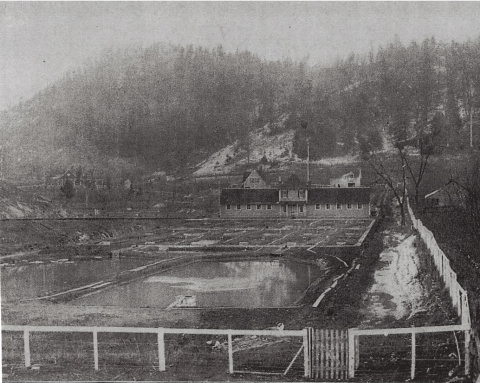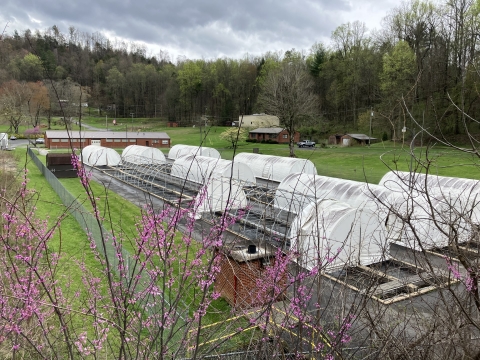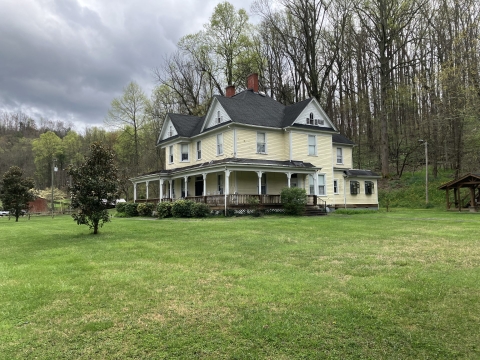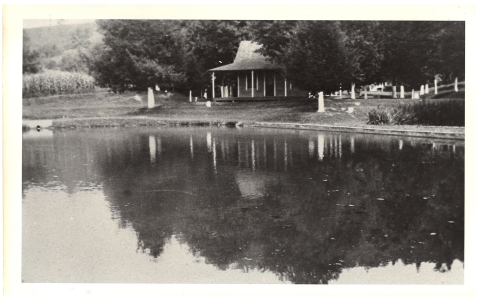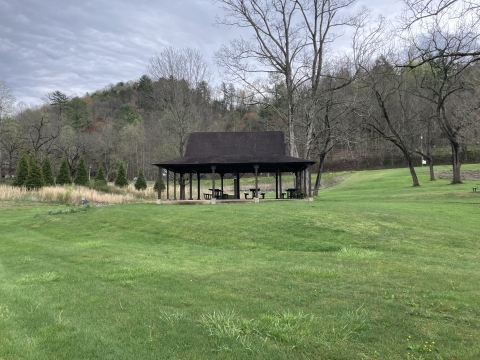Erwin National Fish Hatchery is one of the oldest federally operated hatcheries in the country. The hatchery was established by an Act of Congress on August 8th, 1894 to restore trout populations in Tennessee, North Carolina, and Virginia. Erwin, Tennessee was selected as the location for the hatchery due to the presence of multiple high output springs which serve as the hatchery's source of water. Construction at the hatchery began in 1897, and fish were brought onto the station in November of that year.
During the first year a total of 2,989 brook trout were collected from local streams and were brought back to the hatchery to serve as broodstock broodstock
The reproductively mature adults in a population that breed (or spawn) and produce more individuals (offspring or progeny).
Learn more about broodstock . Unfortunately, for the staff at the time no eggs were obtained that year, and there was high mortality due to predation of the broodstock by feral cats! The next year, 1898, the hatchery received shipments of rainbow trout fingerlings and eggs from another federal hatchery in Wytheville, Virginia and brook trout eggs from East Freetown, Massachusetts. Survival of these fish and eggs were also reported as low due to high nitrogen levels in the spring water, and with predation from snakes and other nuisance species. This sounds ridiculous in today's intensively managed fish culture world, but it thanks to the efforts of and the lessons learned by our predecessors have made Erwin NFH so successful today.
By 1900 Erwin NFH staff were successfully rearing trout and stocked approximately 40,000 rainbow trout and 30,000 brook trout that year! The hatchery also began raising bass and other species of fish at the hatchery in addition to the trout.
During the early days of the hatchery fish were primarily stocked by railcar. A special rail siding was added to the hatchery so special rail cars could pull off and load up with fish. This rail stop also served as the Fishery, Tennessee Post Office! The hatchery primarily stocked eastern Tennessee and western North Carolina, along with three counties in Virginia. In the 1960’s the hatchery expanded its stocking range to include Cumberland County, Kentucky.
Erwin NFH has raised several fish species throughout its years of operation. In the early 1900’s through the 1940’s, Erwin NFH staff raised a variety of species including several you would expect like brook trout, rainbow trout, brown trout, lake trout, bluegill, catfish, largemouth bass, smallmouth bass, rock bass, crappie, yellow perch, and several that are unusual in any time period like goldfish, silver shiners, whitetail shiners, golden shiners, northern hogsuckers. That's sixteen different species! In the 1940’s Erwin reduced the number of species it raised, and began focusing on rainbow trout, brown trout, brook trout, bluegill, largemouth bass, and smallmouth bass.
By the 1950’s, Erwin National Fish Hatchery began to focus solely on trout propagation for mitigation and recreational fishing. In 1976, the hatchery officially became part of the National Broodstock program, and began to provide disease-free eggs to federal, state, and tribal hatcheries.
The hatchery itself has changed several times during our long history. The original facility that was constructed in 1897 included two houses for staff, a hatchery building, outbuildings, and eight ponds. Many more additions to the hatchery soon followed. An office building was constructed in 1901, and the superintendent’s house was built in 1903. In 1909, a new hatchery building was constructed to replace the original, which had fallen into disrepair. Some of the ponds were converted into concrete raceways, and more land was acquired. The additional land allowed for the construction of ponds dedicated to warm-water fish culture on the west side of the railroad tracks.
By the end of the 1950’s all of the ponds on the eastern side of the railroad tracks were converted into raceways, and many of the present hatchery buildings were constructed. These include the feed building, 5-bay garage, and oil house. More construction occurred in the 1960’s, such as the most recent hatchery building, which was built in 1961, along with the pump house for reuse water, generator building, and the only remaining staff quarters house.
The hatchery downsized in the 1970’s, and sold most of the land on the western side of the railroad tracks to the town of Erwin. That land became Fishery Park, which is a popular place in Erwin to fish, swim, or even play tennis. In the early 1990’s the hatchery covered the spring and put weatherport covers on all of the raceways to help reduce the risk of disease. Recent work at the hatchery is focused on creating more habitat for bats and native pollinators, and the creation of a new building to rear non-game fish and mussel species.
Erwin National Fish Hatchery remains a part of the National Broodstock Program, and ships millions of eyed rainbow trout and brook trout eggs each year. Fish from the hatchery are primarily stocked for federal mitigation projects, and for children’s fishing events in eastern Tennessee. Additionally, staff at Erwin NFH assist with several other projects southern Appalachian brook trout restoration projects, Trout in the Classroom, and freshwater mussel surveys. Come visit Erwin National Fish Hatchery to learn more about our hatchery’s amazing past, and all of the work we will continue to do into the future.

